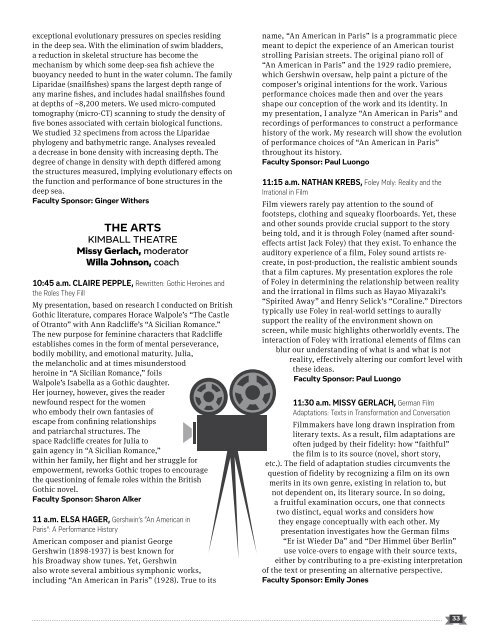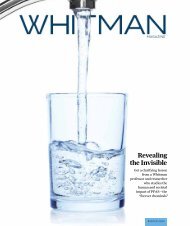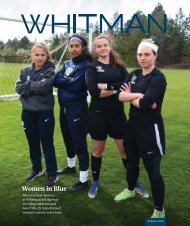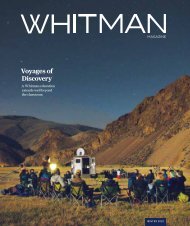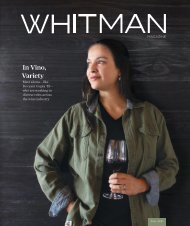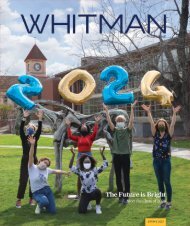You also want an ePaper? Increase the reach of your titles
YUMPU automatically turns print PDFs into web optimized ePapers that Google loves.
exceptional evolutionary pressures on species residing<br />
in the deep sea. With the elimination of swim bladders,<br />
a reduction in skeletal structure has become the<br />
mechanism by which some deep-sea fish achieve the<br />
buoyancy needed to hunt in the water column. The family<br />
Liparidae (snailfishes) spans the largest depth range of<br />
any marine fishes, and includes hadal snailfishes found<br />
at depths of ~8,200 meters. We used micro-computed<br />
tomography (micro-CT) scanning to study the density of<br />
five bones associated with certain biological functions.<br />
We studied 32 specimens from across the Liparidae<br />
phylogeny and bathymetric range. Analyses revealed<br />
a decrease in bone density with increasing depth. The<br />
degree of change in density with depth differed among<br />
the structures measured, implying evolutionary effects on<br />
the function and performance of bone structures in the<br />
deep sea.<br />
Faculty Sponsor: Ginger Withers<br />
THE ARTS<br />
KIMBALL THEATRE<br />
Missy Gerlach, moderator<br />
Willa Johnson, coach<br />
10:45 a.m. CLAIRE PEPPLE, Rewritten: Gothic Heroines and<br />
the Roles They Fill<br />
My presentation, based on research I conducted on British<br />
Gothic literature, compares Horace Walpole’s “The Castle<br />
of Otranto” with Ann Radcliffe’s “A Sicilian Romance.”<br />
The new purpose for feminine characters that Radcliffe<br />
establishes comes in the form of mental perseverance,<br />
bodily mobility, and emotional maturity. Julia,<br />
the melancholic and at times misunderstood<br />
heroine in “A Sicilian Romance,” foils<br />
Walpole’s Isabella as a Gothic daughter.<br />
Her journey, however, gives the reader<br />
newfound respect for the women<br />
who embody their own fantasies of<br />
escape from confining relationships<br />
and patriarchal structures. The<br />
space Radcliffe creates for Julia to<br />
gain agency in “A Sicilian Romance,”<br />
within her family, her flight and her struggle for<br />
empowerment, reworks Gothic tropes to encourage<br />
the questioning of female roles within the British<br />
Gothic novel.<br />
Faculty Sponsor: Sharon Alker<br />
11 a.m. ELSA HAGER, Gershwin’s “An American in<br />
Paris”: A Performance History<br />
American composer and pianist George<br />
Gershwin (1898-1937) is best known for<br />
his Broadway show tunes. Yet, Gershwin<br />
also wrote several ambitious symphonic works,<br />
including “An American in Paris” (1928). True to its<br />
name, “An American in Paris” is a <strong>program</strong>matic piece<br />
meant to depict the experience of an American tourist<br />
strolling Parisian streets. The original piano roll of<br />
“An American in Paris” and the 1929 radio premiere,<br />
which Gershwin oversaw, help paint a picture of the<br />
composer’s original intentions for the work. Various<br />
performance choices made then and over the years<br />
shape our conception of the work and its identity. In<br />
my presentation, I analyze “An American in Paris” and<br />
recordings of performances to construct a performance<br />
history of the work. My research will show the evolution<br />
of performance choices of “An American in Paris”<br />
throughout its history.<br />
Faculty Sponsor: Paul Luongo<br />
11:15 a.m. NATHAN KREBS, Foley Moly: Reality and the<br />
Irrational in Film<br />
Film viewers rarely pay attention to the sound of<br />
footsteps, clothing and squeaky floorboards. Yet, these<br />
and other sounds provide crucial support to the story<br />
being told, and it is through Foley (named after soundeffects<br />
artist Jack Foley) that they exist. To enhance the<br />
auditory experience of a film, Foley sound artists recreate,<br />
in post-production, the realistic ambient sounds<br />
that a film captures. My presentation explores the role<br />
of Foley in determining the relationship between reality<br />
and the irrational in films such as Hayao Miyazaki’s<br />
“Spirited Away” and Henry Selick’s “Coraline.” Directors<br />
typically use Foley in real-world settings to aurally<br />
support the reality of the environment shown on<br />
screen, while music highlights otherworldly events. The<br />
interaction of Foley with irrational elements of films can<br />
blur our understanding of what is and what is not<br />
reality, effectively altering our comfort level with<br />
these ideas.<br />
Faculty Sponsor: Paul Luongo<br />
11:30 a.m. MISSY GERLACH, German Film<br />
Adaptations: Texts in Transformation and Conversation<br />
Filmmakers have long drawn inspiration from<br />
literary texts. As a result, film adaptations are<br />
often judged by their fidelity: how “faithful”<br />
the film is to its source (novel, short story,<br />
etc.). The field of adaptation studies circumvents the<br />
question of fidelity by recognizing a film on its own<br />
merits in its own genre, existing in relation to, but<br />
not dependent on, its literary source. In so doing,<br />
a fruitful examination occurs, one that connects<br />
two distinct, equal works and considers how<br />
they engage conceptually with each other. My<br />
presentation investigates how the German films<br />
“Er ist Wieder Da” and “Der Himmel über Berlin”<br />
use voice-overs to engage with their source texts,<br />
either by contributing to a pre-existing interpretation<br />
of the text or presenting an alternative perspective.<br />
Faculty Sponsor: Emily Jones<br />
33


